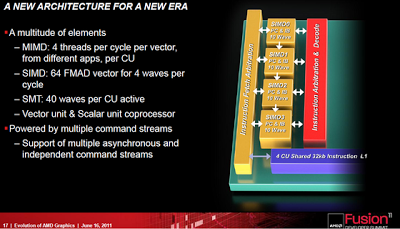VR-zone analyzes the next generation AMD GPU AMD’s next generation GPU architecture was shown at their Fusion Summit a month ago, and expected to materialixe initially in the Radeon HD7000 series a 28 nm process before yearend 2011.
The ‘next gen’ AMD GPU is even more of a ‘graphics-enabled vector processor’ than the Nvidia Fermi in their current GeForce line up attempted to be. Basically, as you see here, we’re talking about a mini Cray supercomputer on a chip, with X86-compatible 64-bit addressing and memory management, essentially able to share both virtual and physical memory with the X86 main processors in the system and, if somehow connected via HyperTransport or QuickPath (later doubted though due to the Intel licensing issues) to the CPU, could literally be a very tightly coupled co-processor with its own memory on a side, yet able to address all the main memory at near CPU speed, without PCIe bottlenecks.
If AMD is to use this brand new GPU architecture in the 28 nm Radeon HD7000 series, it will be the most revolutionary GPU change since the advent of programmable shaders in GPUs half a decade ago. We hope it will not affect the core graphics driver performance or stability, of course, but once the initial hurdles are overrun, this will make for a very interesting new system – and application – architecture. Yes, mixing few wide cores and hundreds of narrow cores in one application at one time may sound like a challenge, but the performance gains may more than justify it.
If you liked this article, please give it a quick review on ycombinator or StumbleUpon. Thanks

Brian Wang is a Futurist Thought Leader and a popular Science blogger with 1 million readers per month. His blog Nextbigfuture.com is ranked #1 Science News Blog. It covers many disruptive technology and trends including Space, Robotics, Artificial Intelligence, Medicine, Anti-aging Biotechnology, and Nanotechnology.
Known for identifying cutting edge technologies, he is currently a Co-Founder of a startup and fundraiser for high potential early-stage companies. He is the Head of Research for Allocations for deep technology investments and an Angel Investor at Space Angels.
A frequent speaker at corporations, he has been a TEDx speaker, a Singularity University speaker and guest at numerous interviews for radio and podcasts. He is open to public speaking and advising engagements.


